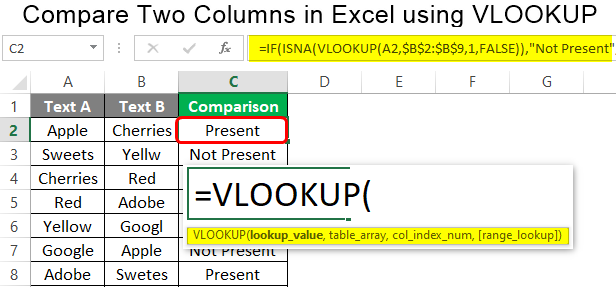Excel VLOOKUP Guide: Match Two Sheets Easily

The Microsoft Excel application is a powerful tool for data analysis and organization, but as data grows, managing and referencing information across multiple sheets can become quite challenging. One of Excel's most useful functions for this task is VLOOKUP. This Excel VLOOKUP Guide will walk you through the process of matching data between two sheets effortlessly, making your data manipulation tasks more efficient and less prone to errors.
What is VLOOKUP?

VLOOKUP, or “Vertical Lookup,” is an Excel function that enables you to search for a value in the first column of a table and return a value in the same row from another column. It’s immensely useful for looking up and retrieving information from a large dataset, matching data from one worksheet to another.
How to Use VLOOKUP

Let’s explore how to apply VLOOKUP to match data between two Excel sheets:
1. Prepare Your Data

Before you can use VLOOKUP, ensure your data is structured properly:
- Your lookup column must be the first column in the range you’re searching.
- The data in your lookup column should be unique to avoid multiple matches.
- Make sure there are no blank or merged cells in your lookup range.
2. The VLOOKUP Function Syntax

The syntax for VLOOKUP is:
VLOOKUP(lookup_value, table_array, col_index_num, [range_lookup])
- lookup_value: The value you want to find in the first column of the table array.
- table_array: The range of cells that contains the data.
- col_index_num: The column number from which you want to return a value.
- range_lookup: A logical value, FALSE for an exact match, TRUE or omitted for an approximate match.
3. Example: Matching Data Between Two Sheets

Imagine you have two sheets: “Sheet1” with employee IDs and names, and “Sheet2” with employee IDs and their corresponding sales figures:
On Sheet1:
| Employee ID | Name |
|---|---|
| E101 | John Doe |
| E102 | Jane Smith |
| E103 | Bob Johnson |

On Sheet2:
| Employee ID | Sales |
|---|---|
| E101 | 10,000</td></tr> <tr><td>E102</td><td>12,000 |
| E103 | $15,000 |
To match sales to the employees on Sheet1:
- Select the cell where you want the sales data to appear (let's say B2 on Sheet1).
- Type the following VLOOKUP formula:
- A2 is the lookup_value: the ID of the employee on Sheet1.
- Sheet2!A$1:B$4 is the table_array: the range where the IDs and Sales figures are located on Sheet2.
- 2 is the col_index_num: we want to return the second column, which is Sales.
- FALSE ensures we get an exact match.
=VLOOKUP(A2, Sheet2!A$1:B$4, 2, FALSE)
Repeat this formula for each employee on Sheet1 to match their sales figures.
4. Handling Errors

If VLOOKUP can’t find the lookup value, it will return #N/A. Here are some common issues and fixes:
- Check for Typographical Errors: Ensure the lookup_value exactly matches the data in the table_array.
- Data Range Issues: Confirm that the table_array includes all the data you need.
- Column Index: Double-check the column index number. Remember, it’s not zero-based in Excel.
- Use IFERROR for Error Handling:
=IFERROR(VLOOKUP(A2, Sheet2!A1:B4, 2, FALSE), “Data not found”)
🔍 Note: Always use exact match (FALSE) when you require precise data matching.
5. Advanced Tips and Tricks

- Named Ranges: Use named ranges to simplify your VLOOKUP formulas.
- Dynamic Range: Use functions like OFFSET and COUNTA to make your range dynamic, adapting to changes in data.
- Double VLOOKUPs: You can nest VLOOKUP functions within each other to match data across three or more tables.
These advanced techniques can significantly enhance your Excel capabilities, making your data handling more efficient.
6. Automating VLOOKUP Tasks

Excel offers features like Power Query or VBA for automating VLOOKUP tasks:
- Power Query: Use to connect and transform data from multiple sources.
- VBA: Write macros to perform VLOOKUP operations on large datasets with ease.
💡 Note: Automation can save time, especially when dealing with repetitive VLOOKUP tasks.
In conclusion, the VLOOKUP function in Microsoft Excel is an indispensable tool for data reconciliation and matching between sheets. By understanding how to effectively use VLOOKUP, you can streamline your data analysis process, reduce errors, and save a significant amount of time. From basic data lookup to more complex data manipulations, VLOOKUP's versatility makes it a must-know for anyone working with Excel.
What does #N/A error in VLOOKUP mean?

+
The #N/A error signifies that VLOOKUP couldn’t find the lookup_value within the specified table_array. This can occur due to typographical errors, incorrect column index, or data range issues.
Can I use VLOOKUP to search horizontally?

+
Yes, but not directly with VLOOKUP. For horizontal lookups, use the HLOOKUP function instead, or transpose your data to make it vertical.
How can I make VLOOKUP faster?

+
Limit the range of your table_array to only what’s necessary, use named ranges, or consider using INDEX and MATCH functions for potentially better performance in larger datasets.



